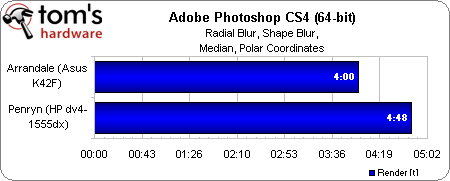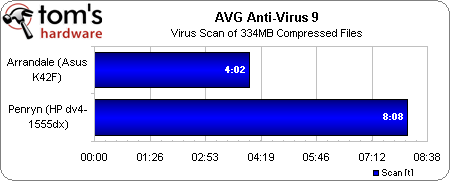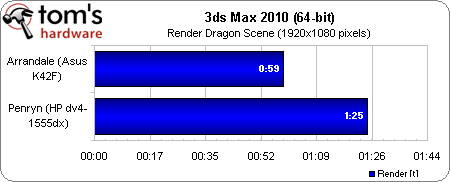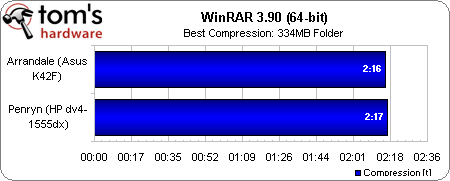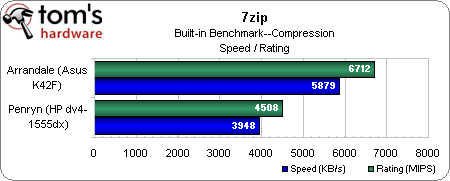Intel’s Mobile Core i5 And Core i3: Arrandale Is For The Rest Of Us
Benchmark Results: Productivity
Our threaded Photoshop benchmark demonstrates an advantage in favor of Intel's Hyper-Threading technology, as Asus' K42F beats out the competing HP Penryn-based machine.
The difference between a dual-core processor and a dual-core processor with Hyper-Threading is staggering in AVG 9. We’ve seen this same behavior in past performance evaluations, where the anti-virus suite uses very little resources, but rewards the shift to more logical cores with a halved completion time.
We know that this one is threaded, so the massive speed-up in going with the Arrandale platform is attributable mostly to Hyper-Threading (though we also know a Turbo-equipped CPU under its TDP will still add a 133 MHz bin of acceleration, even when both cores are being utilized).
Considering that WinRAR is threaded, it’s interesting to see Hyper-Threading having little effect on this test’s overall standing. For the most part, both of these mobile platforms are even.
In a big contrast to WinRAR, 7-Zip shows a massive gain in favor of Hyper-Threading. The speed (KB/s) and rating (MIPS) components of our compression routine really accelerate Intel's Arrandale processor.
Get Tom's Hardware's best news and in-depth reviews, straight to your inbox.
Current page: Benchmark Results: Productivity
Prev Page Benchmark Results: Media/Transcoding Apps Next Page Power Consumption-
burnley14 Well played, Intel. You've been knocking it out of the park lately, keep up the good work.Reply -
I'm looking forward to getting an HP laptop with the Arrandale Core i5 processor in the near future.Reply
-
It's going to be interesting to see the performance/battery time of the LM and UM processors as I'm in the market for a thin-and-light myself.Reply
Performance is good but I'm hoping for a viable update to the CULV offerings of yesterday. -
Computer_Lots Looks like there are finally some replacements for the Atom, at least in efficiency anyway. Too bad the price is currently too high for the UM versions of these processors to make their way into netbooks. I would guess that even the i5-520UM would destroy the Atom in every benchmark, except maybe power consumption.Reply -
HansVonOhain C2D was one of the longest living platforms. But newer tech will replace slower processors.Reply
Keep it up intel. I do hope that AMD will release some new chips that will be able to compete with intel offerings. -
jasperjones ^^^ true that. arrandale will further diminish AMD's role in the mobile processor market. and there's nothing coming up before may.Reply -
Luscious Chris, the dv4 series from HP has a 12-cell extended battery available as well rated for 94Wh 2.2A. Once HP makes the transition to Arrandale, all else being same, you can expect the dv4 to hit 8-10 hours easy.Reply -
cangelini Thanks for the tip Lucious. I didn't have the higher-capacity battery available to test, but I'd absolutely love to see 8-10 hrs. real-world from an Arrandale-based machine.Reply -
Reynod Good bye NVidia ...Reply
That chops them completely out of the mobile graphics market for the masses ... Intel will pay the RIGHT OEM's some "adjustment" just to make sure their "Strategy" is right to ensure AMD's mobile market is thin and restricted to the backwaters of Bejjing.
